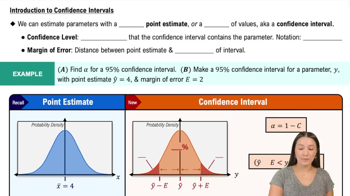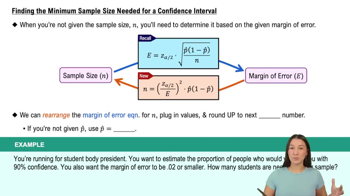Here are the essential concepts you must grasp in order to answer the question correctly.
Confidence Level
The confidence level represents the degree of certainty that the true population parameter lies within the confidence interval. A 99% confidence level means that if the survey were repeated multiple times, 99% of the calculated intervals would contain the true percentage of adults who believe in astrology. This high level of confidence indicates a strong assurance in the results, but it also requires a larger sample size.
Recommended video:
Introduction to Confidence Intervals
Margin of Error
The margin of error quantifies the range within which the true population parameter is expected to fall, based on the sample results. In this case, a margin of error of four percentage points means that the estimated percentage of adults who believe in astrology could be four points higher or lower than the survey result. A smaller margin of error requires a larger sample size to achieve greater precision in the estimate.
Recommended video:
Finding the Minimum Sample Size Needed for a Confidence Interval
Sample Size Calculation
Sample size calculation is the process of determining the number of respondents needed to achieve a desired level of confidence and margin of error. When estimating proportions, the formula incorporates the confidence level, margin of error, and an estimate of the population proportion. In this scenario, since no prior estimate is available, a conservative approach is often used, typically assuming a proportion of 0.5 to maximize the required sample size.
Recommended video:
Sampling Distribution of Sample Proportion






